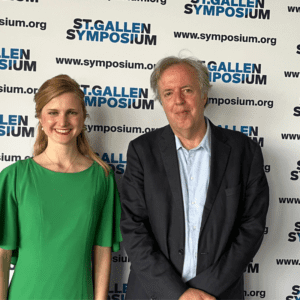Neil Koenig, ideaXme board advisor interviews Sarah Maria Nordt, Founder of SANOGE.
The Planetary Cost of the Fashion Industry
Neil comments:
The fashion industry might be glamorous, but its allure comes at a cost, since it is widely regarded as being one of the world’s biggest sources of pollution. One entrepreneur who is trying to do something to improve the situation is Sarah Maria Nordt. She’s the co-founder of SANOGE, a fashion tech start-up based in Germany that aims to produce clothing in a more sustainable manner. It eschews mass production in favour of making clothes on demand. SANOGE’s website works a bit like a car configurator, with customers having the ability to modify the design of the garments they would like, which are then produced to order. The hope is that this approach will help, amongst other things, to reduce overproduction and return rates.
Before launching SANOGE, Sarah Maria Nordt studied at the University of St. Gallen in Switzerland. Every year the university hosts a Symposium, a vast gathering of leaders and thinkers from all over the world, and I caught up with Sarah Maria at this year’s event. In this interview with me for ideaXme, Sarah Maria Nordt talks about how she came to found her enterprise, the daunting challenge of making the fashion industry a more sustainable one, and her hopes and dreams for the future.
Sarah Maria Nordt, ideaXme interview
Neil Koenig, ideaXme board advisor: [00:00:00] We are here to idea everyone. To fire up your curiosity and connect you with the people and ideas that shape our world. Watch, Listen. Understand. Connect. Create. Let’s Move the human story forward™ together.

This stain proof garment is made by SANOGE, a start-up based in Germany that wants to make fashion more sustainable by ditching mass production in favour of making clothes on demand. At this year’s symposium at the University of St. Gallen in Switzerland, SANOGE founder Sarah Maria Nordt was one of the speakers.
I’m Neil Koenig. And I began my interview for ideaXme with Sarah Maria Nordt by asking her to tell us more about her business.
SANOGE | The Future of Fashion
Sarah Maria Nordt, founder SANOGE: [00:00:55] We take technology to reshape the future of the fashion industry by making it more sustainable, more secure for all the workers involved along the supply chain, and also to increase the value we deliver to the customers. We are tackling some of the greatest challenges the fashion industry is facing nowadays, which is overproduction. 10 to 30% of all products are overproduction. That means they’re never listed in any e-commerce store. They’re never seen in a retail store, but it just produced and then automatically destroyed again. And we tackled this issue with tech driven on demand production. First aspect, what we’re doing. Second one is return rates. 60 to 80% of all e-commerce purchases are returned in these days. And that’s another very severe issue that’s affecting the environmental footprint of the fashion industry. We are also tackling that by building an emotional bond between the product and the customer. So long story short, what we are actually doing is we’ve been creating a fashion configurator in the front end that turns customers into the co-designer of their perfect piece of apparel. So, in a modularized building block system, they can choose between different colours of fabrics, types of fabrics, design components, and thereby create a piece of apparel that’s perfectly matching his or her needs. So, from a conceptual perspective, you can compare it to a car configurator. That’s the front end and then the back end, this is linked to an artificial intelligence driven automated production system. So, we handle all that complexity that comes with the individualization component, with artificial intelligence in the back end to ensure that production processes are very lean, that they are very resource efficient, and they can happen just in time.

Neil Koenig, ideaXme board advisor: [00:02:53] So customers design their own clothes? Is that it?
Sarah Maria Nordt, founder SANOGE: [00:02:57] That’s it. So, we turn basically customers into co-designers to bring in their own personality into the apparel they’re going to wear after they have chosen how they would like to look. So, it starts with the idea that we all want to be unique, and fashion is kind of covering the largest parts of our body. So, this is a very strong instrument of communication. And in the past, we’ve always been used to wearing standard designs, to wearing standard sizes, to wearing something that has been created by someone in a very anonymous way, in a very anonymous sense. Previously, we did not have the power or the way to bring in our own personality. And this is what we are changing because we say fashion should be as unique as the person wearing it. And this is then where do the co-design function comes in to really enable every customer to bring in their own personality, to bring in their own preferences and to create something which is unique, as unique as the person wearing it, and thereby also building this emotional bonding between the product and the customer. Because once we empower the customer to really create his or her own design, we go beyond trends to true personality.
“Fashion is Fate and Style is Eternal”
Sarah Maria Nordt, founder SANOGE: [00:04:15] There is a quote by Yves Saint Laurent: “fashion is fate and style is eternal”. And this is something which we are very much living up to because sustainability really lies in this eternity, in creating pieces that are timeless, creating pieces that have high quality and customers really enjoy wearing, and they never get out of trends.
Neil Koenig, ideaXme board advisor: [00:04:38] So what sort of clothes can customers configure on your system?
Sarah Maria Nordt, founder SANOGE: [00:04:42] So as of today, we’re starting with Ladies’ business, where that means shift dresses, blouses, shirts, etcetera. Everything that the modern businesswoman needs to be perfectly dressed in a professional, but also the more casual context. But this is only the first thing to come. Next step is definitely to expand, to menswear. We are already in preparation of that. And then also to take the configurator and to take all the CAD complexity that’s standing behind that and collaborating with other fashion brands. We call that our B2B designers’ platform to also onboard them and get them on the journey of this very sustainable and future oriented on demand production.
Neil Koenig, ideaXme board advisor: [00:05:27] What sort of price are we talking price wise?
Sarah Maria Nordt, founder SANOGE: [00:05:30] We are actually comparable to all the other business wear that’s out there. So, for dresses, for example, Hugo Boss, woman for blouses, Van Laack blouses, in the premium segment. And this is also our big aim to make sustainability something which is affordable for everyone and not only accessible for a very thin luxury segment for sure this is also interesting from a luxury segment perspective, but for us it is really about bringing sustainability to the market, where also a non-usual luxury segment customers can afford it.
Neil Koenig, ideaXme board advisor: [00:06:07] And how is it going?
Sarah Maria Nordt, founder SANOGE: [00:06:09] Great. So, we’re growing steadily. We are very, very happy. Our team is growing steadily and that’s for me is always kind of the KPI because new team means that we have had additional customers, that our revenues are growing, that we can excite and dress up even more women currently, that we can cooperate with even more corporations with even more brands in terms of this B2B designer’s platform. And that’s kind of our indicator that things are going well.
Neil Koenig, ideaXme board advisor: [00:06:37] Yeah, sustainability in fashion is a trend that has been on the horizon for some time, and some of the large fashion luxury conglomerates have been trying to get involved in this. How are they doing?
The Fashion Industry World-wide is the Second Biggest Polluter
Sarah Maria Nordt, founder SANOGE: [00:06:59] Oh, it’s really hard to judge about someone else, but let’s put it that way. There is a reason why we take sustainability so seriously. This industry really is calling for radical transformation. So, the fashion industry worldwide is the second largest polluter. That makes up 2.1 billion tons of CO2 emissions every year, 42 million tons of plastic waste. And that’s responsible basically for 10% of all global CO2 emissions can be attributed to the fashion industry. And this number is expected to increase by [00:07:38] another 50% until 2030. [00:07:41] So that’s immense. You’ve been asked how the other fashion players are doing. And maybe it’s not my job to really judge what they are doing, but maybe I can give like some from our very technology driven perspective, some tips on the way the industry should change in order to make sustainability become the leading paradigm. And there are basically three big levers. The big first, big lever is overproduction. So, overproduction in the fashion industry amounts 10 to 30% of all production volumes – something that’s produced and then destroyed again. Once we succeed in eliminating overproduction, this is also a call to all the other fashion brands and players out there. We will succeed in eliminating 30% of CO2 emissions of the entire industry, 30% of wastewater, and also 30% of transportation routes. And that would make up coming back to the total global emissions of the fashion industry, which is 10% of the total global CO2 emissions. That would mean 3% less total global CO2 emissions. That’s huge!
How to Stop Over Production in the Fashion Industry
Sarah Maria Nordt, founder SANOGE: [00:08:56] That’s massive. That’s a really big lever we have in our hands, and we should really use. One approach to realize that is, for example, on demand production because only that is really ordered by customer is then going to be produced and we can just eliminate all this waste and garbage we are producing as of today. So that’s the first big lever. Second big lever, urban manufacturing. Urban manufacturing is not the very promising approach to go if you want to, to make the fashion industry cleaner and more environmental and also society friendly. That means bringing production closer to where actually the demand is. It does not mean to bring production facilities into like downtown New York City centre. It just means, for example, to bring production, if the demand is in America for the American customers to America or for the European customers to Europe, instead of shipping goods around the globe for, on average 40,000 kilometres per product. Third big lever is customer centricity. We should really put the customer at the centre of what we are doing and instead of telling customers what they actually want, really empower them, and inspire them to bring in their own personality and to build this emotional bonding between themselves and the product. And this is really where we can empower the customers to create timeless pieces and timeless pieces are pieces customers really enjoy wearing over and over again. And then will also help us to get out of this crazy circle of fast fashion.
Can Sustainability be Fashionable?
Neil Koenig, ideaXme board advisor: [00:10:32] Can you make sustainability fashionable? I mean, are people going to buy this? Isn’t part of the dream, particularly at the luxury end of the market, the fact that you’ve got this brand with a lot of heritage behind it and some famous designer designing the product? Isn’t that part of the appeal? And they don’t really want to think about anything else, the customers?
Sustainable Fashion. SANOGE, Less Waste, More Luxury
Sarah Maria Nordt, founder SANOGE: [00:10:55] That definitely is the case. However, sustainability in the future is not going to be a path or an option to choose. It’s really a must have. So, we as a global society cannot afford not to be sustainable because otherwise on this beautiful blue planet, there will be no human beings anymore that can then wear these very iconic pieces of very famous designers. So, sustainability is also something that pertains very much to luxury brands, that pertains very much to premium brands such as this is to the mass market, to the fast fashion industry. So, this is something where we really have to change, and we need to make sure that “sustainable” is always the most attractive, most appealing solution to choose from. So, one reason why we founded SANOGE, our start-up, is to ensure that this is the case, to show that we can package sustainability into a win, win package for everyone. So, for the planet, for the customer, and also to pack that in economically profitable terms that we are not like missing out any of these very important and mutually influencing components. Fair fashion, sustainable fashion of the future cannot take the format of, as we might know it as of today from the Fair-Trade store where we have some pullovers with sometimes strange designs knitted by someone I don’t know with not so good skills. So, this is not what we should have in mind when we think of sustainable fashion. Sustainable fashion is super chic. It’s super high quality. It can be super prestigious. It can go hand in hand with luxury brands.
Does SANOGE have Competitors?
Neil Koenig, ideaXme board advisor: [00:12:43] Do you have competitors?
Sarah Maria Nordt, founder SANOGE: [00:12:44] We are basically competing with basically with all the large fashion brands that are nowadays delivering or offering ladies business wear. In comparison to the men’s business market, the women’s market is not as developed, where we have large offerings of made to measure apparel, which we also do in the female market, and that’s quite of a blank spot. We’re also competing with the en vogue ready to wear brands of today. However, what we can deliver, what they cannot as of today is individualization, is 100% supply chain transparency and is really making sure that every fibre, every stitch of the needle in this product is truly sustainable because we all keep it in house in our all-manufacturing unit. This is this is really the key differentiator and then really empowering the customers. So, if you go to our competitors, you can choose from their range of designs. They’re changing every collection every season. They’re offering different standard pieces to you. If you come to us, you might not have this super-duper, highly prestigious brand. Not yet, as we’re still growing, but still, you can bring in your own personality. And I think there is no better brand than one’s own personality.
Neil Koenig, ideaXme board advisor: [00:14:08] What are your biggest challenges at the moment?
Scaling the SANOGE Fashion Brand
Sarah Maria Nordt, founder SANOGE: [00:14:12] So growth. Growth goes hand in hand with challenges. Scaling a company is always something where we are building on different construction zones at the same time. So, keeping pace with the team growth, keeping pace with production and facilities, keeping pace with the technology that everything is working hand in hand. This is one big challenge we are working on. We see it as an opportunity. And this starts or this has so many different components. It starts with how to grow sustainably, truly sustainably. It’s how to do marketing, how to communicate the value we are selling to customers because we want to make sure we are just not selling products. We really also want to educate our customers, to really convince them and show them the reasons why it makes so much sense to go this very customer centric on demand, I become the co-designer myself way. We take care how we phrase it. How we communicate, not to do dumb marketing, but really to do inspiring marketing to empower our customers and make them even stronger. With every new piece of apparel they’re designing, they’re wearing and they’re yeah, they’re turning into their favourite piece of the wardrobe.
Neil Koenig, ideaXme board advisor: [00:15:36] What advice would you have for young people who want to do something like you’re doing?
Growing a Start-up
Sarah Maria Nordt, founder SANOGE: [00:15:44] Be bold. Be ambitious and be ready to work hard. So, I would say founding, growing and then scaling a start-up is really calls for hard work and it calls for a very, very strongly defined vision. So, you really have to be clear about your purpose. It’s really why you as the you mentioned, like the young person, you’re here, you’re doing this, and you are 100% there with your skin in the game. So, this is something that should really be purpose driven and you should be all in fully standing behind that with all you have, and then follow your dreams and turn them into reality.
Interview credit: Neil Koenig.
If you enjoyed this interview check out our interview with Stela Solar, Director of the National AI Centre, CSIRO Australia.

Neil Koenig: LinkedIn https://www.linkedin.com/in/neilkoenig/
ideaXme links: ideaXme https://radioideaxme.com ideaXme is a global network – podcast on 12 platforms, 40 countries, mentor programme and creator series. Mission: To Move the human story forward™. Our passion: Rich Connectedness™!
